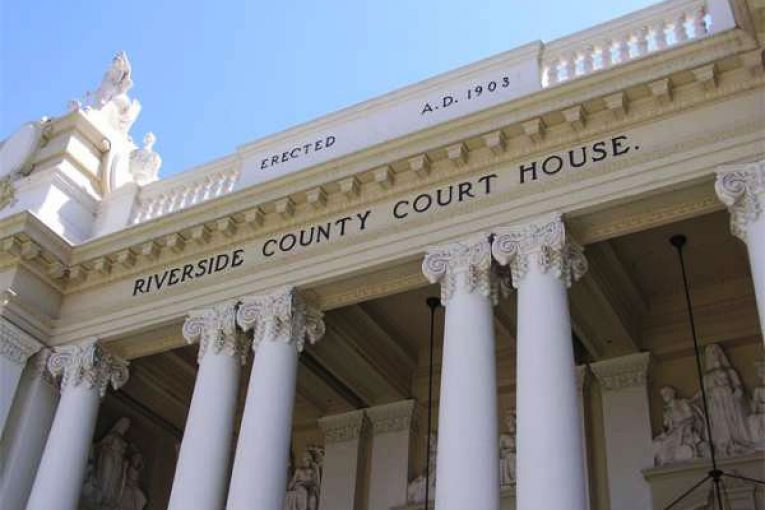

By Ashleen Herrarte and Talia Kruger
INDIO, CA – The trial for brothers Moses Olaez and Manuel Olaez proceeded Monday here in Riverside County Superior Court—among their charges are murder and attempted murder with other felonies and misdemeanors, including gang membership, carrying a concealed firearm and possession of controlled substances.
In November of 2016, a group of men that allegedly included Moses and Manuel Olaez went to the railroad tracks in Hemet, CA, where one of them fatally shot one person, and attempted to shoot a minor who had been with the victim. In April of 2017, the Olaez brothers were arrested for the crime. They pleaded not guilty.
It was noted that a “Jane Doe” was at the shooting, an informant, during a purchase of firearms. The officer Monday said Doe went to a residence where another man went inside the house and had a conversation with others. When he came back he was with Moses Olaez.
The officer said Doe and Moses and the other man went to an auto repair shop where they met with a buyer about the firearms, which were purchased for a total of $2,100. Doe paid both Moses and the other man $100 each for the transaction.
These firearms were purchased with money given to Doe by law enforcement and the serial numbers had been recorded.
The officer testified he did not see this transaction of firearms happen but was informed through radio communication.
The prosecution then moved to nine days later, where a similar deal to the one just discussed happened. Doe was to purchase firearms and a quarter pound of methamphetamine.
During this purchase, Doe purchased two shotguns and two rifles for $3,100.
Defense lawyers Michael Schaaf and James Boyd tried to discredit Jane Doe’s credibility as an informant.
Boyd noted inaccuracies in the money amounts that Doe had testified under oath about, stating that at one point she had given a dollar amount and then at another point had said she didn’t know the dollar amount.
Later, Boyd said Doe might have been involved in drug use.
Officer Henkin (no first name given) said on the stand he discourages informants from using drugs, and not to give information while under the influence.
Defense Attorney Boyd then noted a prior charge in which drug paraphernalia was found in Doe’s car.
Henkin countered this by saying that while that could be an indication of drug use with the informants he worked with and the people they were often around, the drugs found in her car could have belonged to others.
Boyd also brought up a shoplifting charge levied against Doe and questioned Henkin on whether or not shoplifting was, in his experience, often an indication of drug use.
Henkin responded yes, but maintained that he did not believe that Doe was on drugs at the time he worked with her.
Boyd then questioned Henkin as to whether or not informants were allowed to sleep with targets, to which Henkin responded no.
Boyd questioned Henkin, asking if Doe had been sleeping with one of the accused, and he confirmed that Doe had admitted this to him.
Boyd then questioned Henkin if Doe was sleeping with Moses and Henkin said that she had insisted that she wasn’t.
Boyd stated to the jury and court that if he was able to prove this claim to be false then this would be another inaccuracy in Doe’s testimony, but he had yet to present evidence of such.
The defense then shifted gears to question the deputy about the gang membership charges and questioned him about an encounter with Moses in which he was brought in wearing a grey hat with the letters LRC (for Las Rasas Controla allegedly) on the outside and “gang graffiti” on the inside.
The defense tried to verify whether or not the deputy had actually seen this hat be confiscated from Moses’s head, to which he responded that he believed so.
The deputy testified that following the murder he had instructed Doe to buy whatever guns she could find in order to find the murder weapon, and encouraged her to buy guns from those specifically with suspected involvement in the murder: Moses and Manuel.
Henkin also testified that any information he received from Doe was corroborated, either through recording or undercover officer.
Regarding gang charges, Henkin explained that he believed Hemet 13 to be a larger umbrella gang that La Raza Control falls under, “like Ford is to Mustang,” and that in this way although Manuel was only linked to Hemet 13, he still believed that he was part of Las Razas like his brother.
The defense tried to counter this claim using Henkin’s Ford metaphor, stating that just because Manuel may have been a “Ford” (Hemet 13) member, this didn’t mean he was part of the subsection “Mustang” (Las Razas.)
Finally, a former deputy who had worked on the case during his time on the force was called to the stand, and testified how in April of 2017, he and other deputies had uncovered four bullet shell casings near the tracks west of Gilbert St. in Hemet.
The former deputy explained that these shells were all 30 caliber casings and were likely all fired from a rifle.
He also testified that the casings were found roughly 275 ft. away from a concrete pad in the aqueduct, where the men were allegedly hanging out before the murder took place.
Following his testimony, the court recess was called for the day and the case is to return Aug. 17 in Department 2F of the Larson Justice Center. 